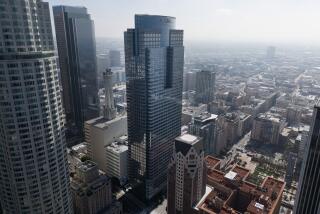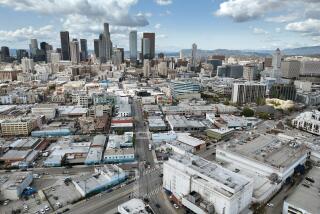Home is where the height is
When Santiago Calatrava’s design for a slender, twisting skyscraper on the Chicago lakefront was unveiled last week, most of the attendant news coverage focused, predictably enough, on the tower’s planned height. At 115 stories and 1,458 feet -- or an even 2,000 feet if you count the spire -- it would rank as the tallest building in the United States and among the three or four tallest in the world.
Despite suggestions after Sept. 11 that the skyscraper might become an architectural victim of the age of terrorism, here was fresh evidence, wrapped in a sleek and camera-friendly package, that the desire to build tall had returned to pre-2001 levels. And maybe even exceeded them.
But buried in those reports was evidence of another, arguably more significant cultural and architectural shift: Calatrava’s vertiginously tall tower, to include 250 condominiums atop a hotel, is planned as a residential building, without a cubicle, water cooler or corner office in sight. The same is true of another matchstick-thin Calatrava skyscraper slated for Lower Manhattan as well as towers Frank Gehry has designed in New York and is designing on Grand Avenue in downtown Los Angeles.
Since its invention in Chicago at the end of the 19th century, the skyscraper, almost by definition, has been designed to hold offices. More than that, it has represented essentially the opposite of domesticity and has been directly tied in the American popular imagination with the idea of work, careerism and the corporation -- first in a gray-suited, martinis-on-the-sideboard sort of way, and then, as the World Trade Center towers and other skyscrapers became symbols of U.S. hegemony and terrorist targets, in a manner more complex and politically fraught.
Now the skyscraper is being re-imagined -- perhaps reborn -- as a place to live. And its form is changing as a result, from blocky to tapering, promising a vitality in tall-building architecture unseen since the 1930s.
The change, just beginning to emerge in the U.S., has been more pronounced in other parts of the world, in designs by many of architecture’s biggest talents. In Malmo, Sweden, Calatrava’s Turning Torso building, a shorter, more muscular cousin of the Spanish architect’s Chicago tower, will devote 38 of its 50 floors to apartments when it’s finished later this year. Renzo Piano’s London Bridge Tower, scheduled to open in 2009, will fill two-thirds of its 66 floors with apartments and hotel rooms. In Beijing, the most compelling of the city’s countless new skyscraper projects is a series of bone-white condominium towers by the Japanese architect Riken Yamamoto.
In this country, the trend has been driven in significant part by laws, now decades old in some cities, legalizing condominium conversion and construction -- as well as, more recently, a prolonged slump in the commercial real-estate market. In downtown Los Angeles, for example, the office vacancy rate is roughly 16%. And since technology and changing work schedules mean that there is less reason for employees to gather in a central, concentrated workplace, the commercial market in downtown towers may never rebound completely.
Just as important, despite the office-space slump, city centers have experienced a collective revival over the last decade. Crime rates have fallen sharply. Young professionals are marrying later and thus staying in cities longer. And many baby boomers are eager, after their children leave home, to buy an apartment or pied-a-terre downtown.
Together, these trends have driven up demand and prices for high-end condominiums as quickly as the rest of the housing market. Condos in the Calatrava building, to be known officially as the Fordham Spire, will start at $600,000 for a one-bedroom unit and go as high as $5 million for full-floor apartments near the top of the building. Those rates -- roughly $850 per square foot -- aren’t especially expensive by Los Angeles or New York standards, but they will qualify as pricey in Chicago.
In an interview last week, the tower’s developer, Christopher Carley, insisted that the growing condo market in Chicago warrants the extra construction costs that Calatrava’s unusual design will entail.
“You can’t really justify hiring a top-notch international architect on a rental building,” he added, but a high-end condo project is a different story.
In cities as dense as New York and Chicago, developers have long found residential towers financially attractive. But with very few exceptions -- notably the John Hancock Center in Chicago, where the comedian Chris Farley was found dead in a 60th-floor apartment in 1997 -- they have tended to be mid-rise buildings, generally from 10 to about 45 stories. The same is true of the many residential conversion projects now underway in downtown Los Angeles and of the condo towers sprouting in Century City, Miami and elsewhere.
Iconic status in American culture, meanwhile, has been reserved for the tallest of towers, generally 50 to more than 100 stories: the Empire State Building, the Sears Tower, the World Trade Center and the like. And at that height skyscrapers have always been primarily commercial. Yet Calatrava’s Chicago spire -- as both the tallest tower in the city and the most idiosyncratic architecturally -- would immediately become a hugely symbolic presence on the skyline. And even at less than half that height, Gehry’s Grand Avenue tower seems likely to become a landmark in similarly quick fashion.
All of this makes it hugely disappointing that New York Gov. George Pataki and the other decision-makers at ground zero couldn’t force developer Larry Silverstein to accept at least some housing at the World Trade Center site, instead of the 10 million square feet of commercial space he has insisted on rebuilding. The residential demand is clearly there, at least in the minds of Silverstein’s competitors: The planned Lower Manhattan towers by Gehry and Calatrava are slated for sites within about half a mile of ground zero.
There remains some doubt about how the public will greet the idea of living in new residential buildings that are not just tall but staggeringly so. In the post-9/11 era, living in a 35th- or 40th-floor apartment in a tower in Westwood or Seattle can hardly be compared to the prospect of moving into the top floor of Calatrava’s Chicago skyscraper, nearly 1,500 feet above the sidewalk.
And the question of whether a very tall skyscraper stripped of its corporate symbolism would remain an attractive target for terrorists is a difficult one. While the Sept. 11 plotters surely chose the twin towers because they symbolized American financial might, they also did so simply because the buildings were the tallest objects on the New York skyline. The same is true of Al Qaeda’s alleged planned targets in Chicago (Sears Tower) and Los Angeles (U.S. Bank Tower).
A different issue is what this programmatic shift will mean for skyscraper architecture, for the look of the buildings that crowd together in our downtowns and on our waterfronts. The early signs are encouraging. Traditional skyscrapers, despite diverse kinds of cladding and decoration and the modest variety imposed by setback requirements, have generally shared the same broad-shouldered rectangular bulk, since commercial developers consider identical, repeating floor plates easier to build and lease.
Many of the new residential towers, by contrast, have a dramatically tapering silhouette. While that form never proved really workable for office towers -- despite the well-known example of the Transamerica Pyramid in San Francisco -- it makes sense for the developers of residential skyscrapers, especially when a building calls for wide floor plates near the ground level for retail or cultural space and condominiums on the upper floors.
Smaller floors near the top mean that the residents will never be more than a few steps from their windows and views. It also makes for more full-floor units, which are a key amenity in high-end residential buildings. Who wants to pay $5 million for an apartment and have to share a hallway?
Already there’s been an effort to coin names for the new style. Londoners have compared Piano’s tower to a shard of glass. Within days of its debut, Calatrava’s wispy Chicago design had been likened to a drill bit, a blade of grass and a woman in a dress.
Critics of that building have taken to calling it simply “the screw.” Some worry about an oversaturated condo market in Chicago. Others have charged that Carley, the developer, is enlisting Calatrava more as a flashy marketing device than as an architect. There are plenty of Chicagoans who believe that the spire’s chances of being built are about as slim as its profile.
Still, the appearance of skyscrapers full of apartments rather than offices is directly connected to the way that Americans are redefining work and home life and rediscovering the round-the-clock appeal of dense cities. And those changes seem unlikely to reverse themselves even if Calatrava’s Chicago tower never gets off the ground.
*
Christopher Hawthorne is The Times’ architecture critic.
More to Read
Sign up for Essential California
The most important California stories and recommendations in your inbox every morning.
You may occasionally receive promotional content from the Los Angeles Times.











